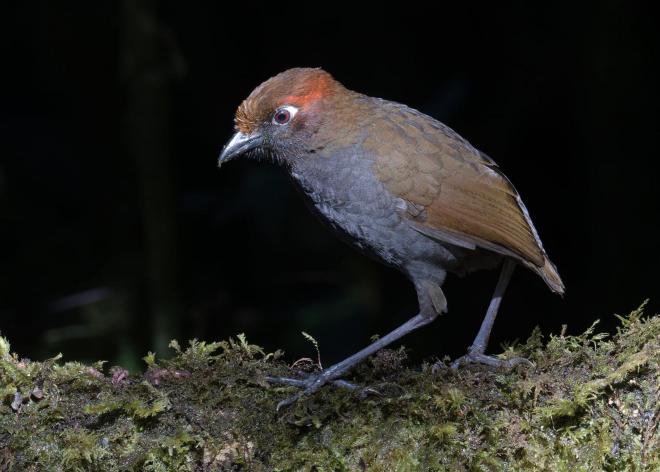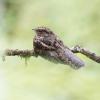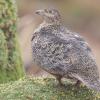Day 1 - March 6. Arrival in Quito and transfer to hotel near airport.
Day 2 - March 7. Today we drive to Antisana National Park, a beautiful area in the highlands with a Paramo Ecosystem, similar to tundra. In this area we’ll search for hummingbirds like the Ecuadorian Hillstar, and the largest hummingbird in the world, the Giant Hummingbird. We have an excellent chance to see the rare and endangered Andean Condor, which is also the national bird of Ecuador. Other raptors are possible including Variable Hawk, Carunculated Caracara, and Black-chested Buzzard-Eagle. Andean Ibis, Andean Lapwing, Paramo Pipit, Chestnut-winged Cinclodes, and Andean Gull are all possible on the paramo. On the high elevation lakes and reservoirs, we'll look for Silvery Grebe, Andean Duck, Slate-colored Coot and others.
After lunch we will drive to Papallacta Pass where we’ll search for Rufous-bellied Seedsnipe, Rainbow-bearded Thornbill, Giant Conebill, Red-rumped Bush-Tyrant, Black-backed Bush-Tanager, Viridian Metaltail and others. The elevation we reach today exceeds 4,200 meters (14,000 ft)! The scenery can be beautiful with high mountain peaks and scattered lakes and ponds. There is a chance we could spot Andean Bear today, as well as other mammals like Andean White-tailed Deer and Andean Fox, also known as Culpeo. We will spend the night at Guango Lodge.
Day 3 - March 8. We will spend much of our day exploring trails at the fantastic Guango Lodge. One of our big targets will be Gray-breasted Mountain-Toucan. We have an excellent chance of seeing them at close range as they feast on grapes and other fruits. Tanagers are also a highlight at Guango Lodge, where we could see several species including the uncommon Lacrimose Mountain-Tanager, as well as Grass-green Tanager, Red-hooded Tanager, Golden-hooded Bush-Tanager and Hooded Mountain-Tanager, to name a few species. Hummingbirds are also featured at Guango Lodge, where feeders and flowers attract many species including Mountain Velvetbreast, Tourmaline Sunangel, Chestnut-breasted Coronet, Collared Inca, Speckled Hummingbird, and the tiny White-bellied Woodstar. Feeders and moth sheets attract all varieties of birds from Turquoise Jay, and the 'Inca' race of Green jay, to Gray-browed Brushfinch, Mountain Cacique, Black-capped Hemispingus and Capped Conebills. Night at Guango Lodge.
Day 4 - March 9. This morning we will try and track down any species we didn't get good views of the day before at Guango Lodge. We'll then make our way to the famous Guacayamos Ridge, home to many exciting species of birds. Here, we will look for Greater Scythebill, Chestnut-breasted Wren, Peruvian and Slate-crowned antpittas, and Rusty-winged Barbtail, as well as Barred Antthrush, Hooded Mountain-Tanager and the Black-billed Mountain-Tanager, amongst others. Later on in the afternoon, we'll drive to WildSumaco Lodge, where we will spend the night. If we arrive in the daylight, you can enjoy the activity at the hummingbird feeders, where Gould's Jewelfronts, Napo Sabrewing, Golden-tailed Sapphire, and Many-spotted Hummingbirds are frequent.
Days 5 & 6 - March 10 & 11. The forest at WildSumaco is loaded with east foothill specialties not easily seen elsewhere. We will spend much of our time birding the dirt roads and forest trails nearby. The possibilities are many, but here is a list of a few of the more tempting birds: Green-backed and Collared trogons, Coppery-chested Jacamar, Gilded and Red-headed barbets, Golden-collared Toucanet, Blackish Rail, Chestnut-fronted Macaw, Black-faced Antbird, Striolated and White-crowned manakins, Fiery-throated Fruiteater, Slaty-capped Shrike-Vireo, Yellow-breasted Antwren, Lafresnaye's Piculet, Chestnut-capped Puffbird, Magpie Tanager, Paradise Tanager, Green-and-gold Tanager, and many more! Nights at WildSumaco Lodge.
Day 7 - March 12. This morning we will make our way to Coca City. From there, a guide from the Napo Cultural Center will join us and take us on a 2 hour canoe ride in Yasuni National Park in the Amazon Rainforest. Our destination will be the Napo Cultural Center. Over 425 species of birds have been recorded here, as well as many exotic mammals and other creatures. On the canoe ride, we will watch for birds like the iconic Hoatzin, as well as a variety of herons and egrets, kingfishers, and more. Perhaps we will spot a Giant River Otter! Night at Napo Cultural Center.
Days 8 & 9 - March 13 & 14. We have two full days to explore the rainforest at the Napo Cultural Center. During this time we will visit the Canopy Tower, a great way to get eye level views of many otherwise hidden birds and arboreal mammals as they venture into the canopy. We will also visit clay licks where a variety of parrots and macaws come in to get salts and minerals. Exploring trails on foot and waterways by canoe, we will look for birds like Black-fronted Nunbird, Swallow-winged Puffbird, Scarlet-crowned Barbet, Many-banded Aracari, White-throated and Channel-billed toucans, Yellow-tufted and Crimson-crested woodpeckers, Cobalt-winged Parakeet, Orange-winged Amazon, Red-bellied Macaw, Bare-necked Fruitcrow, Cattle Tyrant, Russet-backed Oropendola, and Opal-rumped and Opal-crowned tanagers, amongst many more species. Nights at Napo Cultural Center.
Day 10 - March 15. Today we will travel by boat to Sani Lodge, our home base for the next three nights. As we travel along the waterways, we'll keep an eye open for Hoatzins, Amazon Kingfishers, Capped Herons and other waterbird, as well as mammals including Giant River Otter and the bizarre Monk Saki monkey. Night at Sani Lodge.
Days 11 & 12 - March 16 & 17. During 2 full days at Sani Lodge we’ll be accompanied by a local guide that will take us to the canopy tower for seeing and photographing birds at eye level, paddle canoes rides around the lagoon searching for monkeys and water birds, walk forest trails for forest birds and other mammals like Squirrel Monkey, Howler Monkey, Tamarin Monkey, Woolly Monkey, Spider Monkey, Manatee, Jaguar, Cougar, and more.
Some of the species we will look for include: Great and Little tinamou, Horned Screamer, Muscovy Duck, Speckled Chachalaca, Marbled Wood-Quail, Sapphire Quail-Dove, Gray Fronted-Dove, Little Cuckoo, Common Pauraque, Ladder-tailed Nightjar, Great and Long-tailed potoo, Gould’s Jewelfront, Long-billed Starthroat. Blue-tailed Emerald, Purple Gallinule, Gray-breasted Crake, Sungrebe, Limpkin, Wattled Jacana, Sunbittern, Anhinga, Neotropical Cormorant, Least Bittern, Rufescent Tiger-Heron, Cocoi, Little Blue, Agami, Capped and, Boat-billed herons, Bare-faced Ibis, Greater Yellow-headed Vulture, Osprey, Crested Eagle, Least Bittern, Swallow-tailed and Plumbeous kite, Black-tailed and Amazonian trogon, Ringed Kingfisher Pied Puffbird, Ivory-billed Aracari, Golden-collared Toucanet, Channel-billed Toucan, Yellow-tufted, Ringed and Cream-colored woodpecker, Red-throated Caracara, Bat Falcon, Scarlet Macaw, Pygmy Antwren, Gray and Black-faced antbird, Black-banded Woodcreeper, Dwarf Tyrant-Manakin, Blue-capped and Wire-tailed manakin, Plum-throated Cotinga, Screaming Piha, Spangled Cotinga, Black-tailed Tityra and many other species. Nights at Sani Lodge.
Day 13 - March 18. Today we will travel from Sani Lodge back to Coca City. From Coca City, we'll stop for lunch and then drive on to San Isidro Lodge, where we spend the next two nights. In the evening, we will search for the 'San Isidro' Owl, a form of Black-banded Owl, as well as Rufous-banded Owl. Moth sheets attract a staggering variety of moths and other insects. Night at San Isidro Lodge.
Day 14 - March 19. The Cabañas San Isidro protects a huge area of primary forest of the buffer zone of the Antisana Ecological Reserve, here we’ll be birding on one of the trails and the main road looking for Green Jay, White-bellied Antpitta, Long-tailed Sylph, Rufous-crowned Tody-Flycatcher, Streak-headed Antbird, Russet-crowned Warbler, Black-billed Peppershrike, Black-eared Hemispingus, Common Bush-Tyrant, Scarlet-rumped Cacique, White-tailed Tyrannulet, White-rumped Hawk, Black-and-chestnut Eagle, Black-chested Fruiteater, Spotted Barbtail, Golden-crowned Flycatcher and many other species.
Around the lodge we’ll watching feeders for Green Hermit, Tawny-bellied Hermit, Sparking Violetear, Brown Violetear, Lesser Violetear, Tourmaline Sunangel, Speckled Hummingbird, Long-tailed Sylph, Tyrian Metaltail, Bronzy Inca, Collared Inca, Buff-tailed Coronet, Peruvian Racket-tail, Green-backed Hillstar, Fawn-breasted Brilliant, Violet-fronted Brilliant, White-bellied Woodstar, Gorgeted Woodstar and Amazilia Hummingbird, to name a few. Night at San Isidro Lodge.
Day 15 - March 20. In the morning we’ll birding around the lodge, checking feeders and moth sheets.
Then around 10:00 am we’ll drive to Guacamayos Ridge looking for Rufous-headed Pygmy-Tyrant, Oleaginous Hemispingus, Dusky Piha, Streaked Tuftedcheek, Plushcap, Flammulated Treehunter, White-bellied Antpitta, Rufous-breasted Flycatcher and other great birds from this area.
In the afternoon we drive back to Quito and then we’ll transfer to the airport to catch your international flight.







